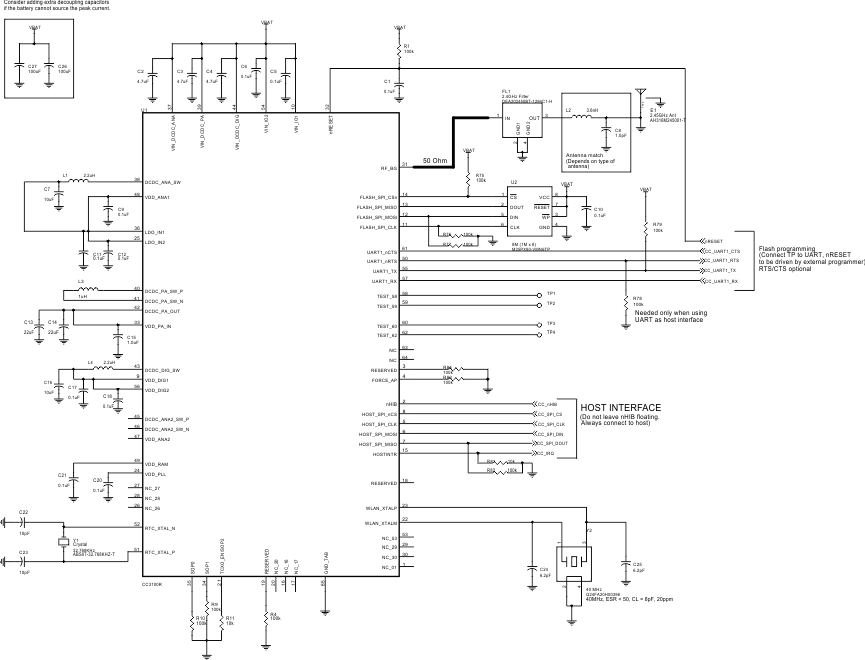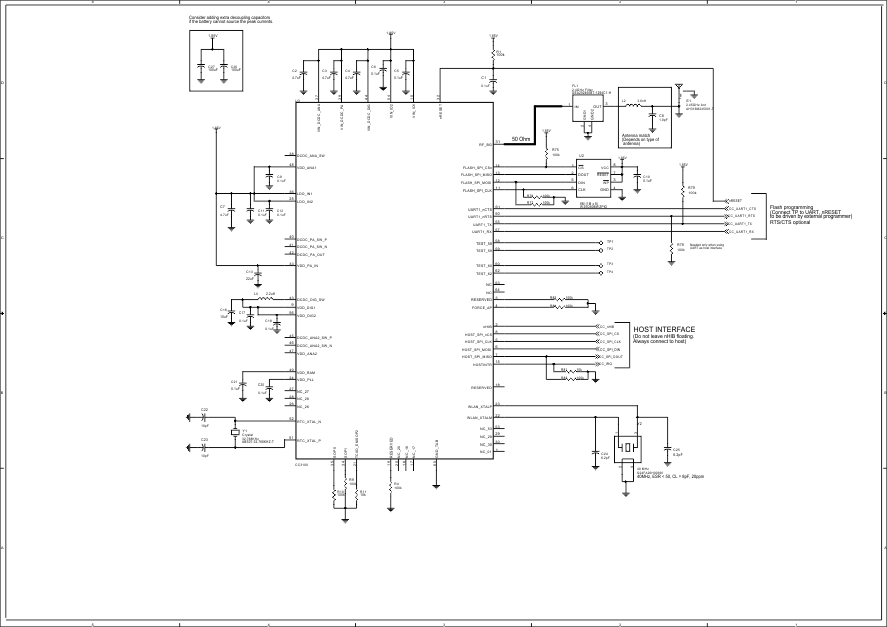SWAS031D June 2013 – February 2015 CC3100
PRODUCTION DATA.
- 1Device Overview
- 2Revision History
- 3Terminal Configuration and Functions
-
4Specifications
- 4.1 Absolute Maximum Ratings
- 4.2 Handling Ratings
- 4.3 Power-On Hours
- 4.4 Recommended Operating Conditions
- 4.5 Brown-Out and Black-Out
- 4.6 Electrical Characteristics (3.3 V, 25°C)
- 4.7 WLAN Receiver Characteristics
- 4.8 WLAN Transmitter Characteristics
- 4.9 Current Consumption
- 4.10 Thermal Characteristics for RGC Package
- 4.11 Timing and Switching Characteristics
- 4.12 External Interfaces
- 4.13 Host UART
- 5Detailed Description
- 6Applications and Implementation
- 7Device and Documentation Support
- 8Mechanical Packaging and Orderable Information
Package Options
Mechanical Data (Package|Pins)
- RGC|64
Thermal pad, mechanical data (Package|Pins)
- RGC|64
Orderable Information
6 Applications and Implementation
6.1 Application Information
6.1.1 Typical Application – CC3100 Wide-Voltage Mode
Figure 6-1 shows the schematics for an application using the CC3100 wide-voltage mode.
Table 6-1 lists the bill of materials for an application using the CC3100 wide-voltage mode.
Table 6-1 Bill of Materials for CC3100 Wide Voltage Mode ApplicationTable 6-1
| Item | Qty | Reference | Value | Manufacturer | Part Number | Description |
|---|---|---|---|---|---|---|
| 1 | 12 | C1 C5 C6 C9 C10 C11 C12 C17 C18 C20 C21 C28 | 0.1 µF | Taiyo Yuden | LMK105BJ104KV-F | CAP CER 0.1 µF 10 V 10% X5R 0402 |
| 2 | 3 | C2 C3 C4 | 4.7 µF | Samsung Electro-Mechanics America, Inc | CL05A475MQ5NRNC | CAP CER 4.7 µF 6.3 V 20% X5R 0402 |
| 3 | 1 | C8 | 1.0 pF | Murata Electronics North America | GJM1555C1H1R0BB01D | CAP CER 1 pF 50 V NP0 0402 |
| 4 | 1 | C13 | 22 µF | Taiyo Yuden | AMK107BBJ226MAHT | CAP CER 22 µF 4 V 20% X5R 0603 |
| 5 | 1 | C16 | 10 µF | Murata Electronics North America | GRM188R60J106ME47D | CAP CER 10 µF 6.3 V 20% X5R 0603 |
| 6 | 2 | C22 C23 | 10 pF | Murata Electronics North America | GRM1555C1H100FA01D | CAP CER 10 pF 50 V 1% NP0 0402 |
| 7 | 2 | C24 C25 | 6.2 pF | Kemet | CBR04C609B1GAC | CAP CER 6 pF 100 V NP0 0402 |
| 8 | 2 | C26 C27 | 100 µF | TDK Corportation | C3216X5R0J107M160AB | CAP CER 100 µF 6.3 V 20% X5R 1206 |
| 9 | 1 | E1 | 2.45G Hz Ant | Taiyo Yuden | AH316M245001-T | ANT BLUETOOTH WLAN ZIGBEE WIMAX |
| 10 | 1 | FL1 | 2.4G Hz Filter | TDK-Epcos | DEA202450BT-1294C1-H | FILTER BANDPASS 2.45 GHZ WLAN SMD |
| 11 | 1 | L2 | 3.6 nH | Murata Electronics North America | LQP15MN3N6B02D | INDUCTOR 3.6 nH 0.1 nH 0402 |
| 12 | 1 | L4 | 2.2 µH | Murata Electronics North America | LQM2HPN2R2MG0L | INDUCTOR 2.2 µH 20% 1300 mA 1008 |
| 13 | 1 | U1 | CC3100 | Texas Instruments | CC3100R1 | 802.11bg Wi-Fi Processor |
| 14 | 1 | U2 | 8M (1M x 8) | Winbond | W25Q80BWZPIG | IC FLASH 8 Mb 75 MHZ 8WSON |
| 15 | 1 | Y1 | Crystal | Abracon Corporation | ABS07-32.768KHZ-T | CRYSTAL 32.768 KHZ 12.5 pF SMD |
| 16 | 1 | Y2 | Crystal | Epson | Q24FA20H00396 | CRYSTAL 40 MHZ 8 pF SMD |
NOTE
Use any 5% tolerance resistor 0402 or higher package.
6.1.2 Typical Application – CC3100 Preregulated 1.85-V Mode
Figure 6-2 shows the schematics for an application using the CC3100 preregulated 1.85-V mode.
Table 6-1 lists the bill of materials for an application using the CC3100 preregulated 1.85-V mode.
Table 6-2 Bill of Materials for CC3100 Preregulated 1.85-V Mode Application
| Item | Qty | Reference | Value | Manufacturer | Part Number | Description |
|---|---|---|---|---|---|---|
| 1 | 12 | C1 C5 C6 C9 C10 C11 C12 C17 C18 C20 C21 C28 | 0.1 µF | Taiyo Yuden | LMK105BJ104KV-F | Capacitor, Ceramic: 0.1 µF 10 V 10% X5R 0402 |
| 2 | 4 | C2 C3 C4 C7 | 4.7 µF | Samsung Electro-Mechanics America, Inc | CL05A475MQ5NRNC | Capacitor, Ceramic: 4.7 µF 6.3 V 20% X5R 0402 |
| 3 | 1 | C8 | 1.0 pF | Murata Electronics North America | GJM1555C1H1R0BB01D | Capacitor, Ceramic: 1 pF 50 V NP0 0402 |
| 4 | 1 | C13 | 22 µF | Taiyo Yuden | AMK107BBJ226MAHT | Capacitor, Ceramic: 22 µF 4 V 20% X5R 0603 |
| 5 | 1 | C16 | 10 µF | Murata Electronics North America | GRM188R60J106ME47D | Capacitor, Ceramic: 10 µF 6.3 V 20% X5R 0603 |
| 6 | 2 | C22 C23 | 10 pF | Murata Electronics North America | GRM1555C1H100FA01D | Capacitor, Ceramic: 10 pF 50 V 1% NP0 0402 |
| 7 | 2 | C24 C25 | 6.2 pF | Kemet | CBR04C609B1GAC | Capacitor, Ceramic: 6 pF 100 V NP0 0402 |
| 8 | 2 | C26 C27 | 100 µF | TDK Corportation | C3216X5R0J107M160AB | Capacitor, Ceramic: 100 µF 6.3 V 20% X5R 1206 |
| 9 | 1 | E1 | 2.45-GHz Ant | Taiyo Yuden | AH316M245001-T | Antenna, Bluetooth: WLAN ZigBee WIMAX |
| 10 | 1 | FL1 | 2.4-GHz Filter | TDK-Epcos | DEA202450BT-1294C1-H | Filter, Bandpass: 2.45 GHz WLAN SMD |
| 11 | 1 | L2 | 3.6 nH | Murata Electronics North America | LQP15MN3N6B02D | Inductor: 3.6 nH 0.1 nH 0402 |
| 12 | 1 | L4 | 2.2 µH | Murata Electronics North America | LQM2HPN2R2MG0L | Inductor: 2.2 µH 20% 1300 mA 1008 |
| 13 | 1 | U1 | CC3100 | Texas Instruments | CC3100R1 | 802.11bg Wi-Fi Processor |
| 14 | 1 | U2 | 8M (1M x 8) |
Winbond | W25Q80BWZPIG | IC Flash 8 Mb 75 MHz 8WSON |
| 15 | 1 | Y1 | Crystal | Abracon Corporation | ABS07-32.768KHZ-T | Crystal 32.768 kHz 12.5 pF SMD |
| 16 | 1 | Y2 | Crystal | Epson | Q24FA20H00396 | Crystal 40 MHZ 8 pF SMD |
NOTE
Use any 5% tolerance resistor 0402 or higher package.

